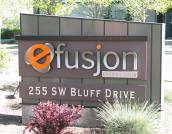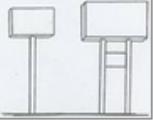9.50.030 Definitions.
The following definitions apply in this chapter:
Alteration means the modification of the size, shape, or height of a sign; also includes changes to the sign location, illumination, and the replacement of sign materials with other comparable materials, such as the replacement of wood parts with metal parts. “Alteration” does not include normal maintenance and repair of an existing sign or changing the sign colors or sign copy on a removable sign face or sign panel insert in a cabinet style sign.
Animated sign means any sign that incorporates movement by electric, mechanical or kinetic means including, but not limited to, rotation, revolving or wind activation of all or a portion of sign; or incorporating flashing or intermittent light for sign illumination, including rotating or intermittent lighting in windows and on buildings.
Awning means a shelter projecting from and supported by the exterior wall of a building and composed of a covering of rigid or nonrigid materials and/or fabric on a supporting framework that may be either permanent or retractable.
Awning sign means a sign displayed on or attached flat against the surface or surfaces of an awning. The entire awning shall be included in the sign area calculation when the awning is backlit and the awning material exhibits the characteristics of luminosity obtained by means of a source of illumination.
Banner means a flexible material on which a sign or graphic may be displayed. Banners are temporary signs and do not include flags as defined in this section. Banners include tear drop flags and similar signs.
Billboards are only those freestanding sign structures which are identified in Table 3.
Building signs are those that are attached, painted, etched or otherwise installed on a structure. Building signs include wall signs, window signs, projecting signs, awning and canopy signs.
Canopy, attached means a multi-sided overhead structure supported by attachments to a building on one or more sides and either cantilevered from such building or also supported by columns at additional points.
Canopy, freestanding means a multi-sided overhead structure supported by columns, but not enclosed by walls, which is installed as a permanent building structure under which vehicles can be driven.
Clear vision area means the area in which no sign structure or device is permitted to dangerously limit the visibility of persons in motor vehicles on streets or alleys.
Copy means the text, graphics or message of a sign.
Directory sign means a sign with multiple sign panels designed to be read on site, located at a multi-tenant development or group of buildings.
Discernible means the physical attributes of a sign that allow for an observer’s differentiation of its letters, words, numbers, or graphics.
Flag means a piece of fabric attached to a flag pole or other support on one side, excluding banners. The length at right angles to the support must be at least as long as the length of the attached side.
Freestanding sign means a sign principally supported by one or more columns, poles, or braces placed in or upon the ground. Ground-mounted, monument and pole signs are subtypes of freestanding signs.
1. Ground-mounted sign means a freestanding sign with a solid base directly and continuously connected to at least 50 percent of the sign face width or with two bases of at least 12 inches in width, measured at the narrowest dimension, each. The lowest portion of the sign face in a ground-mounted sign is at least 12 inches, but less than eight feet, above grade.

2. Monument sign means a freestanding sign that has a solid supporting base equal to or greater than the width of the sign face and at least 12 inches high with no separations between the sign and base. The sign and base may be one integrated unit. If not an integrated unit, the supporting base shall be a minimum 12-inch vertical height.

3. Pole sign means a freestanding sign with the lower edge of the sign face located from one to eight feet above grade and that is not a monument or a ground-mounted sign.

Gateway sign means a primary freestanding sign located at an entrance of a community master planned development.
Grade means the existing landscape before construction or newly established landscape after construction, exclusive of any berming, filling, mounding, or excavating solely for the purpose of elevating a freestanding sign.
Illuminated sign means a sign that contains or consists of lights or a light source or that is illuminated by another light source intended primarily to illuminate the sign. The following definitions apply to illuminated signs:
1. Exposed illumination means a light source that is seen such as neon, fiber optics and bare bulbs that are not external illumination.
2. External illumination means an external light source directed to illuminate the exterior surface of the sign. External illumination includes downlit (lit from above), uplit (lit from below) and backlit; provided, that the light does not transmit through translucent material.
3. Internal illumination means a source of illumination entirely within the sign which makes the sign face visible at night by means of light being transmitted through a translucent material and where the source of illumination is not visible.
4. Opaque means any material which does not allow light to pass through it.
5. Translucent means any material which allows light to pass through it.
Light pole means any luminaire set on a pole which raises the source of light off of the ground. The pole must be permanent and supported by a footing. New luminaires must comply with the Outdoor Lighting Ordinance.
Lot means a legally created parcel of land.
Mansard roof means a four-sided roof having a double slope on all sides, with the lower slope much steeper than the upper.
Master sign plan means a coordinated and balanced plan for signage on a development site which specifies the size, type, illumination, height, design, location and number of signs for the new development or the redevelopment of a site. There are two types of master sign plans (MSP): minor sign plan and major sign plan. See BC 9.50.170.
Model means any three-dimensional object displayed for advertising purposes including, but not limited to, graphics, logos, models of people, bottles, animals, buildings, ships, and aircraft; sculpture; vehicles; hot air balloons.
Multiple-faced primary freestanding sign means a primary freestanding sign with three or more separate sign cabinets, or one or more sign cabinets with three or more separate sign panels, designed to allow replaceable copy without altering the sign. “Alteration” is as defined in this section.

Mural signs are a subcategory of a wall sign and consist of paint applied directly to the exterior wall of a building, or the mural sign consists of paint applied directly on a structure and is not a sign type included in Table 1. Mural signs may not include any additional materials including, but not limited to, electrical components or lighting, dimensional structural elements, or automated methods that cause changes in the appearance of the mural.
Nonconforming sign means a sign that was lawful when erected, but that does not comply with this chapter.
Nonstructural trim means the molding, battens, caps, latticing, cutouts or letters attached to the sign structure.
Parapet wall means the extension of a false building wall that extends above the edge of the roof.
Permanent sign means any sign that is affixed to a building, window, or structure, or to the ground in a manner that enables the sign to resist environmental loads, such as wind, and that precludes ready removal or movement of the sign.
Portable sign means a movable sign that is not attached to a structure or the ground. Portable signs include A-frame signs, T-frame signs, and similar signs.
Primary facade means that portion of a building facade providing the primary public entrance into the primary use building and which may or may not face the public street, also known as a storefront. Multiple-tenant buildings may have individual primary facades or share a common primary facade. The primary is located on the first story and provides pedestrian access into the building from sidewalks, parking lots, and/or other areas from the first floor. The primary shall be the basis for determining the permissible sign area for building signs.
Primary freestanding sign means a freestanding sign installed adjacent to and oriented towards a right-of-way.
Principal use building means the building in which the principal use of the site is conducted. Sites with multiple principal uses may have multiple principal buildings; however, storage buildings, garages and other accessory structures or uses shall not be considered as the principal use building.
Projecting sign means a sign that projects from and is supported by a wall of a building with the display surface of the sign in a plane perpendicular to or approximately perpendicular to the wall.
Recreational vehicle means a vehicle with or without motive power that is designed for human occupancy and to be used temporarily for recreational, seasonal or emergency purposes and as further defined, by rule, by the Director of the Department of Consumer and Business Services.
Right-of-way means land that is owned by the public for transportation and utility facilities.
Roof sign means a sign which is affixed on the slope of the roof or roof-mounted equipment structure or projects higher than the roofline or roof eave. Signs on parapet walls or mansards are considered wall signs.

Roofline means the top edge of a roof or building parapet; excluding any cupolas, chimneys, or other projections.
Sign means the physical components of materials placed or constructed primarily to convey a message or other display.
Sign band means the prominent flat horizontal area located on the first story of a building directly above storefronts or primary entrances and architecturally designed for wall-mounted signs.
Sign District means a specified boundary within the City, as designated by City Council and incorporated into the Sign District Map. See Figure 9.50.040, Sign District Map.
Sign face means the surface upon, against or through which the sign copy or message is displayed or illustrated.
Site means a lot or contiguous lots under common ownership developed under a development approval.
Street frontage means the width of a legal tax lot measured along the line separating the lot from a street.
Suspended sign means a sign attached to the underside of a canopy or awning and supported by the canopy or awning.
Temporary sign means a sign that is intended to be placed for a brief time, and is not a permanent sign.
Urgent care center means a medical facility that delivers unscheduled ambulatory treatment for issues that require immediate care but are not serious enough to require treatment at a hospital 24-hour emergency department.
Wall sign means a single-sided sign that is attached to or painted on an exterior wall of a building, parapet or mansard so that the sign face is parallel or approximately parallel to and within 18 inches of a building wall, parapet or mansard. A mural sign is a subcategory of a wall sign.
Window area means an individual pane of glass or a contiguous area of glass separated by nonstructural elements of dissimilar (non-glass) material or by structural materials.
Window sign means any sign applied, painted, or affixed to a window, or displayed inside the building within two feet of a window or building opening so that it is oriented to the window. Customary displays of merchandise behind a store window are not considered window signs. [Ord. NS-2400, 2021; Ord. NS-2399, 2021; Ord. NS-2340, 2019; Ord. NS-2303, 2018; Ord. NS-2292, 2017; Ord. NS-2279, 2016]